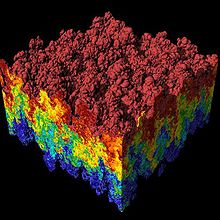- Morse potential
-
Computational physics 
Numerical analysis · Simulation
Data analysis · VisualizationParticleScientistsThe Morse potential, named after physicist Philip M. Morse, is a convenient model for the potential energy of a diatomic molecule. It is a better approximation for the vibrational structure of the molecule than the quantum harmonic oscillator because it explicitly includes the effects of bond breaking, such as the existence of unbound states. It also accounts for the anharmonicity of real bonds and the non-zero transition probability for overtone and combination bands. The Morse potential can also be used to model other interactions such as the interaction between an atom and a surface.
Contents
Potential Energy Function
 The Morse potential (blue) and harmonic oscillator potential (green). Unlike the energy levels of the harmonic oscillator potential, which are evenly spaced by ħω, the Morse potential level spacing decreases as the energy approaches the dissociation energy. The dissociation energy De is larger than the true energy required for dissociation D0 due to the zero point energy of the lowest (v = 0) vibrational level.
The Morse potential (blue) and harmonic oscillator potential (green). Unlike the energy levels of the harmonic oscillator potential, which are evenly spaced by ħω, the Morse potential level spacing decreases as the energy approaches the dissociation energy. The dissociation energy De is larger than the true energy required for dissociation D0 due to the zero point energy of the lowest (v = 0) vibrational level.
The Morse potential energy function is of the form
Here r is the distance between the atoms, re is the equilibrium bond distance, De is the well depth (defined relative to the dissociated atoms), and a controls the 'width' of the potential (the smaller a the larger the well). The dissociation energy of the bond can be calculated by subtracting the zero point energy E(0) from the depth of the well. The force constant of the bond can be found by Taylor expansion of V(r) around r = re to the second derivative of the potential energy function, from which it can be shown that the parameter, a, is
 ,
,
where ke is the force constant at the minimum of the well.
Of course, the zero of potential energy is arbitrary, and the equation for the Morse potential can be rewritten any number of ways by adding or subtracting a constant value. When it is used to model the atom-surface interaction, the Morse potential is usually written in the form
where r is now the coordinate perpendicular to the surface. This form approaches zero at infinite r and equals − De at its minimum. It clearly shows that the Morse potential is the combination of a short-range repulsion and a longer-range attractive tail.
Vibrational States and Energies
To write the stationary states on the Morse potential, i.e. solutions Ψ(v) and E(v) of the following Schrödinger equation:
it is convenient to introduce the new variables:
Then, the Schrödinger equation takes the simple form:
Its eigenvalues and eigenstates can be written as:
where
 ;
; ![N_n=n![\frac{a\left(2\lambda-2n-1\right)}{\Gamma (n+1)\Gamma (2\lambda -n)}]^{\frac{1}{2}}](5/8153c6d602512d4e3c29579b06f1ced7.png) and
and  is Laguerre polynomial:
is Laguerre polynomial:There also exists the following important analytical expression for matrix elements of the coordinate operator (here it is assumed that m > n and
 ) [1]
) [1]The eigenenergies in the initial variables have form:
where v is the vibrational quantum number, and ν0 has units of frequency, and is mathematically related to the particle mass, m, and the Morse constants via
 .
.
Whereas the energy spacing between vibrational levels in the quantum harmonic oscillator is constant at hν0, the energy between adjacent levels decreases with increasing v in the Morse oscillator. Mathematically, the spacing of Morse levels is
 .
.
This trend matches the anharmonicity found in real molecules. However, this equation fails above some value of vm where E(vm + 1) − E(vm) is calculated to be zero or negative. Specifically,
 .
.
This failure is due to the finite number of bound levels in the Morse potential, and some maximum vm that remains bound. For energies above vm, all the possible energy levels are allowed and the equation for E(v) is no longer valid.
Below vm, E(v) is a good approximation for the true vibrational structure in non-rotating diatomic molecules. In fact, the real molecular spectra are generally fit to the form1
in which the constants ωe and ωeχe can be directly related to the parameters for the Morse potential.
Solving Schrödinger's equation for the Morse oscillator
Like the quantum harmonic oscillator, the energies and eigenstates of the Morse potential can be found using operator methods .[2] One approach involves applying the factorization method to the Hamiltonian.
See also
References
- 1 CRC Handbook of chemistry and physics, Ed David R. Lide, 87th ed, Section 9, SPECTROSCOPIC CONSTANTS OF DIATOMIC MOLECULES p. 9-82
- P. M. Morse, Diatomic molecules according to the wave mechanics. II. Vibrational levels. Phys. Rev. 1929, 34, 57-64. doi:10.1103/PhysRev.34.57
- I.G. Kaplan, in Handbook of Molecular Physics and Quantum Chemistry, Wiley, 2003, p207.
Categories:- Chemical bonding
- Quantum chemistry
Wikimedia Foundation. 2010.











![E(v) = h\nu_0 (v+1/2) - \frac{\left[h\nu_0(v+1/2)\right]^2}{4D_e}](6/316542e24f3eb81a6dcbad51090b4e87.png)
